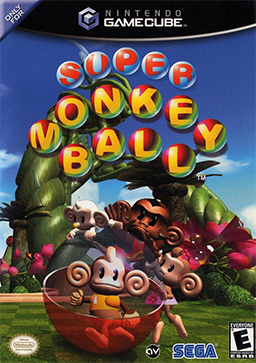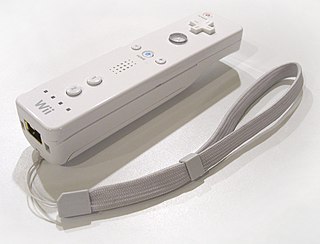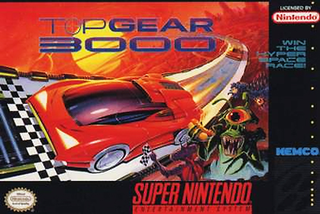Dance Dance Revolution (DDR) is a music video game series produced by Konami. Introduced in Japan in 1998 as part of the Bemani series, and released in North America and Europe in 1999, Dance Dance Revolution is the pioneering series of the rhythm and dance genre in video games. Players stand on a "dance platform" or stage and hit colored arrows laid out in a cross with their feet to musical and visual cues. Players are judged by how well they time their dance to the patterns presented to them and are allowed to choose more music to play to if they receive a passing score.

The Game Boy Player is a GameCube peripheral developed by Nintendo which enables it to play Game Boy, Game Boy Color, and Game Boy Advance cartridges, allowing those games to be played on a television.

Simon is an electronic game of short-term memory skill invented by Ralph H. Baer and Howard J. Morrison, working for toy design firm Marvin Glass and Associates, with software programming by Lenny Cope. The device creates a series of tones and lights and requires a user to repeat the sequence. If the user succeeds, the series becomes progressively longer and more complex. Once the user fails or the time limit runs out, the game is over. The original version was manufactured and distributed by Milton Bradley and later by Hasbro after it took over Milton Bradley. Much of the assembly language code was written by Charles Kapps, who taught computer science at Temple University and also wrote one of the first books on the theory of computer programming. Simon was launched in 1978 at Studio 54 in New York City and was an immediate success, becoming a pop culture symbol of the 1970s and 1980s.

Blockout is a puzzle video game published in 1989 by California Dreams. It was developed in Poland by Aleksander Ustaszewski and Mirosław Zabłocki. American Technos published an arcade version. Blockout is an unlicensed, 3D version of Tetris.

Super Monkey Ball is a 2001 platform party video game developed by Amusement Vision and published by Sega. The game debuted in Japan at the 2001 Amusement Operators Union trade show as Monkey Ball, an arcade cabinet running on Sega's NAOMI hardware and controlled with a distinctive banana-shaped analog stick. Due to the discontinuation of Sega's Dreamcast home console and the company's subsequent restructuring, an enhanced port dubbed Super Monkey Ball was released as a launch title for the GameCube in late 2001, garnering interest as Sega's first game published for a Nintendo home console.

Pop'n Music, commonly abbreviated as Pop'n, PM or PNM and stylized as pop'n music, is a music video game series in the Bemani series made by Konami. The games are known for their bright colors, upbeat songs, and cute cartoon character graphics. Originally released in 1998, the series has had 22 home releases in Japan as well as 30 mainline arcade versions.

Super Monkey Ball 2 is a platform party video game developed by Amusement Vision and published by Sega in 2002 for the GameCube. It is the second installment in the Super Monkey Ball series, and the first installment to have a storyline and to be exclusively released on a home console.

Star Wars: Bounty Hunter is a 2002 action-adventure video game developed and published by LucasArts for the GameCube and PlayStation 2. The PlayStation 2 version was later re-released as a PlayStation 2 Classics title on PlayStation 4 on January 15, 2016. This version was given a limited physical run published and distributed by Limited Run Games on June 28, 2019. An enhanced version developed and published by Aspyr was released for Nintendo Switch, PlayStation 4, PlayStation 5, Windows, Xbox One, and Xbox Series X/S on August 1, 2024.

Daigasso! Band Brothers is a music video game published and developed by Nintendo for the Nintendo DS handheld game console. It was released in Japan on December 2, 2004 as a launch game for the Nintendo DS. The game features multiple songs, which include classical music, television themes, and video game music. The game is controlled using both the buttons on the DS as well as its touch screen in certain portions. It uses a variety of different instruments, which are combined selectively in order to compose a song. Besides the primary mode, players may play together, each one playing a different instrument in the song. Players may also compose their own songs. It was to be released in the United States as Jam with the Band, but was never released nor formally cancelled. It has a sequel titled Jam with the Band, which was released in Japan in 2008 and in Europe in 2010.

Perplexus, originally released as Superplexus, is a 3-D ball-in-a-maze puzzle or labyrinth game enclosed in a transparent plastic sphere. By twisting and turning it, players try to maneuver a small steel ball through a complex maze along narrow plastic tracks. The maze has many steps. The number of steps ranges from 30 in the Perplexus Twist to 225 in the Perplexus 3x3 Rubik's cube Hybrid. Some levels drop the ball into a cup or a small rim to utilize its 3-D nature. Players must complete obstacles varying in difficulty to reach the end.

Mars Matrix: Hyper Solid Shooting, or simply Mars Matrix, is a vertically scrolling shooter arcade game developed by Takumi and released in 2000. The game was published by Capcom and run on their CPS-2 arcade system board. Mars Matrix was later ported to the Dreamcast video game console in 2001. The arcade version uses a horizontally aligned monitor, despite being a vertically scrolling game.

The Wii Remote, informally referred to with the portmanteau Wiimote, is the primary game controller for Nintendo's Wii home video game console. An essential capability of the Wii Remote is its motion sensing capability, which allows the user to interact with and manipulate items on screen via motion sensing, gesture recognition, and pointing using an accelerometer and optical sensor technology. It is expandable by adding attachments. The attachment bundled with the Wii console is the Nunchuk, which complements the Wii Remote by providing functions similar to those in gamepad controllers. Some other attachments include the Classic Controller, Wii Zapper, and the Wii Wheel, which was originally released with the racing game, Mario Kart Wii.

Top Gear 3000, later released in Japan as The Planet's Champ: TG3000, is a racing video game developed by Gremlin Interactive and published by Kemco for the Super Nintendo Entertainment System. It is the third game in the original Top Gear trilogy, and the last in the series to be developed by Gremlin. 3000 heavily resembles the previous Top Gear 2, but is set in the distant future.

The Classic Controller is a game controller produced by Nintendo for the Wii home video game console. While it later featured some compatibility with the Wii U console, the controller was ultimately succeeded by the Wii U Pro Controller. In April 2014, Nintendo discontinued production of both the Classic Controller and Classic Controller Pro.
Shienryū (紫炎龍) is a vertical scrolling shooter created by Warashi for the arcade which was released in 1997, later followed by a Sega Saturn console release in 1997 and PlayStation release in 1999 (JP) and 2002 (US).

The Xbox 360 controller is the primary game controller for Microsoft's Xbox 360 home video game console that was introduced at E3 2005. The Xbox 360 controller comes in both wired and wireless versions. The Xbox controller is not compatible with the Xbox 360. The wired and wireless versions are also compatible with Microsoft PC operating systems, such as Windows XP, Windows Vista, Windows 7, Windows 8, Windows 10, and Windows 11.

The GameCube controller is the standard game controller for the GameCube home video game console, manufactured by Nintendo and launched in 2001. As the successor to the Nintendo 64 controller, it is the progression of Nintendo's controller design in numerous ways. The contentious M-shaped design of its predecessor was replaced with a more conventional handlebar style controller shape; a second analog stick was added, replacing the C buttons with a C stick and the X and Y face buttons, last seen on the Super Nintendo controller, were reintroduced; the shoulder buttons were changed to hybrid analog triggers. A wireless variant of the GameCube controller known as the WaveBird was released in 2002.

Rubik's Slide electronic puzzle game is a Rubik's-branded combination puzzle produced by TechnoSource in 2010. Players must manipulate the circuit to re-create a specified pattern, with 10,000 puzzles built into the device.















